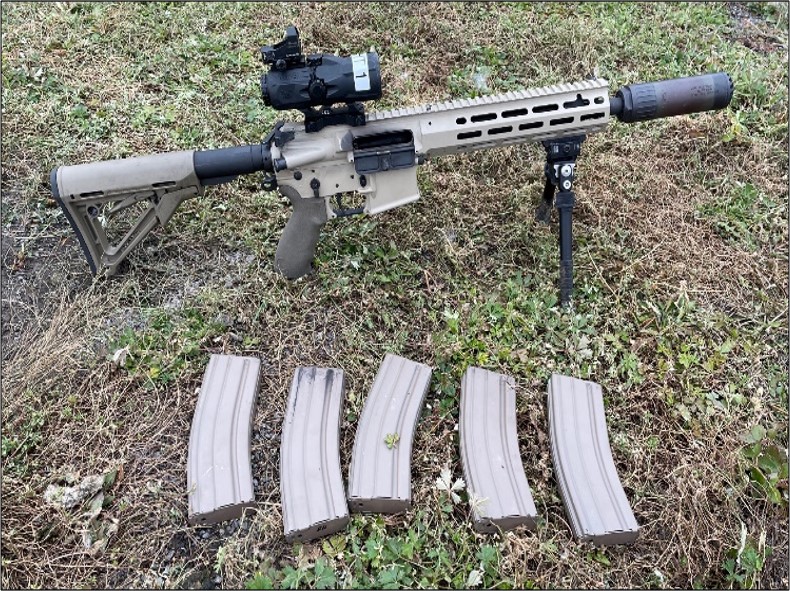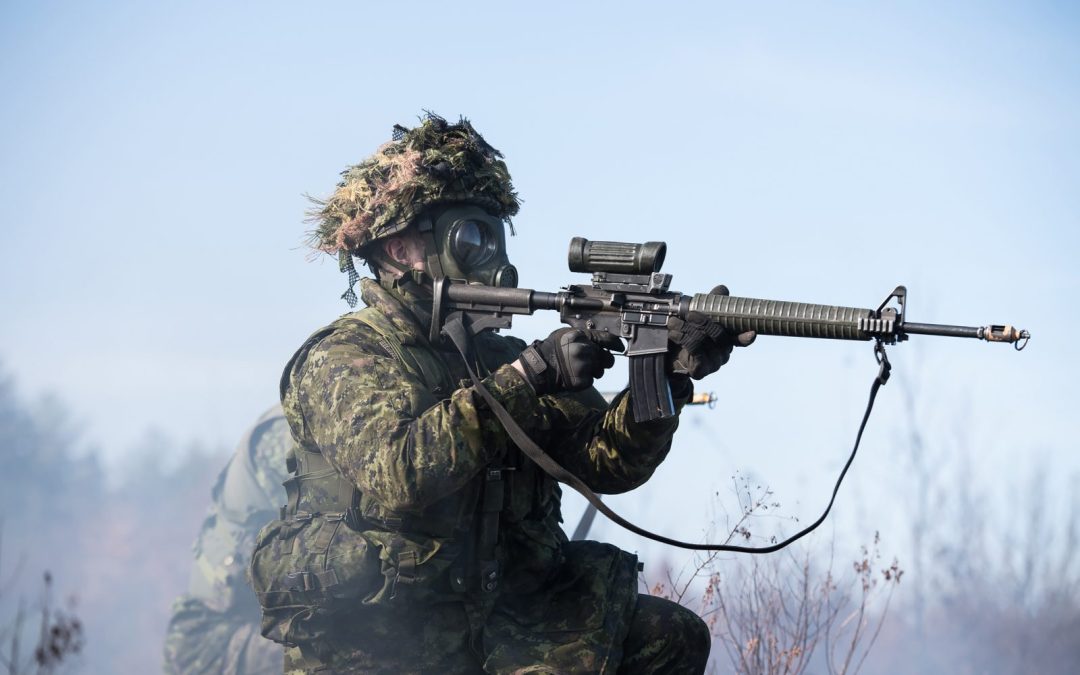by Ken Pole
There’s no gainsaying the history of the Colt Canada C7 rifle in the hands of Canadian Army operators – essentially an evolution of the venerable U.S. Colt M16 that has been used by many NATO allies. But neither is there any question that it has been overtaken technically after more than three decades.
The government acknowledged that in its 2017 Strong, Secure and Engaged (SSE) defence policy, confirming the Army would undergo long-term recapitalization of “much of its land combat capabilities.” Among those was a new Canadian Modular Assault Rifle (CMAR) to replace the C7, the Canadian version of the M16A2.
Ensuring the CMAR plan becomes reality is up to a small team coordinated by Major Carl Gendron, program director of Army Small Arms. A member of the storied Royal 22e Regiment, his career has included deployments to the Middle East, Bosnia, Afghanistan, and Africa that honed his awareness of modern combat environments.
The CMAR project is currently in the options analysis phase, and he expects to enter “the definition phase by the end of 2022,” he told Canadian Army Today in February. “By then, we’ll know if we’re going to do an upgrade or buy a new design. If it’s a major upgrade to the C7 or C8 or if it’s an entirely new design, we expect it to be made through Colt Canada.”
A division of the historic U.S. firearms company, which is now a brand of the CZ Group, Colt Canada is the government’s Small Arms Strategic Source and Centre of Excellence, with a workforce of some 100 at its facilities in Kitchener, Ont.
Ultimately, Gendron is looking for an initial delivery of CMARs and related gear in 2026-2027, with final deliveries in 2032-2033. But he stressed that “everything would need to go very well. Until I’m ready to submit all the financials and get approvals, I don’t know the exact timeline.” While the budget is not finalized, it’s estimated at around $500 million.
“I wish we could streamline the process,” he replied when asked about what seems to be a lengthy timeline. “One of the big issues is the amount of paperwork the staff is required to produce at each step and level of the process.” The project office must generate large amounts of data, delve into all the technical minutiae and figure out exactly what it’s going to cost. That alone can take three years, by which time “you’ve proven that your plan is affordable and practicable.”

Prototype of a pre-production C8A4/CMAR-GS weapon. Photo: ADM Materiel DSSPM9
Though still highly capable, the C7/C8 is considered by some to be a less able weapon than, for example, the Russian AK-12 assault rifle, which is said to exceed the Canadian rifle in terms of lethality, modularity, target acquisition, night fighting capabilities and operator protection. CAF operators need a weapon that would enable them to function effectively across the entire modern combat spectrum, which can range from the Arctic to jungle or desert, and in congested urban theatres.
Gendron said the CMAR project is expected to yield a two-tier fleet: Full Spectrum (CMAR-FS) rifles optimized for high lethality in complex urban and open terrain offensive operations, and General Service (CMAR-GS) rifles for personnel protection. Regular infantry units, which provide the bulk of fighting dismounted troops, would be the main CMAR-FS recipients, while the CMAR-GS would be for more general distribution.
In parallel, the Army is prototyping the C8A4 upgrade to the current C8A3. This is meant as a test bed for many CMAR features as the C8A4 could become the upgrade option leading to the CMAR-GS. “It is based on the Colt MRR and will be no longer than the current C8 (84 centimetres or 33 inches), including a suppressor,” said Gendron. “We are considering a new scope, new reticle, maybe a red dot also, a new trigger system, and several other improvements. We are currently working with Colt on testing and integration of all the components.”
The CAF C7/C8 inventory currently totals almost 90,000. The CMAR project could reduce the fleet by 10 to 15 percent to better reflect the active employment of the rifles. Despite the fleet reduction, there would still be plenty of CMARs to cover all SSE deployments. Those deployed would be equipped with a mix of CMAR FS and CMAR-GS, which has slightly shorter barrels and range. The additional rifles would be for training and stockpiling to ensure operational readiness.
Other key elements of the CMAR project being considered include improved ergonomics and potentially lighter materials, as well as advanced day/night and close-quarters optics, a suppressor to limit an enemy’s ability to locate where fire is coming from, the option of powering add-ons with a live rail, and the ability to integrate with soldier information and sensing devices.
Then there’s the ammunition. The current NATO standard is a 5.56x45mm round, but Gendron noted in a previous interview about considerations for a new calibre or maintaining .556. In theory, the accuracy with the current calibre is excellent up to 500 metres and it has a surprising amount of energy left at greater distances. So, the project is looking at a new 5.56 mm bullet for the CMARs.
“Beyond extending the range, we can expect a new toxic-free cartridge as lead is a growing environmental and medical concern,” he said. “The aim is to avoid sustained and long-term exposure to lead and related toxic chemicals that can cause medical issues later in life. Low toxicity rounds are becoming the norm as more countries restrict or even ban lead rounds for training.”
That improved round – currently called the XC77A2 – is being developed in conjunction with General Dynamics Ordnance and Tactical Systems and has already undergone testing with CMAR FS and GS barrel configurations.
Gendron noted that prototype live-fire tests of both the weapons and ammunition by users late last year were “very successful.” He declined to elaborate, but the new round and several hundred rifles are slated for production this year to support larger scale testing and trials.



The C-7 introduced the 5.56 round to the CAF. Thirty years on, are we sure that another 5.56 round will be effective 30 years hence? How far out is DLR projecting? Not far enough, I fear. Even a lead-free variant isn’t giving us a leap in capability.
Sure, it’s hard to get out too far ahead of what NATO allies are doing, but are we sure that staying with the same round is the right thing to do? Recall that Western MBTs long ago (early 1980s) began to cash in 105mm for 120mm, and it looks like the next tank round may be 130mm. If our new rifles are expected to serve 30+ years, we’d better get ahead of the curve now! Investigate the feasibility of the CMAR design to take the American 6.8mm. By the time the procurement comes around, we can choose whether or not to ‘trade up’, and to take advantage of the economies of scale that go with larger US ammunition procurements. Since CMAR is going to be limited to front-liners, why not do as the US Army is doing and give them a technological leg up?
6.8 mm is not yet nato standard. AFAIK no one else is going to 6.8 yet. Still it’s a good idea to at least engineer the new rifles in several calibers to be on the curve should 6.8 or something else become the new standard.
Hold on there the round the us is using is 6.8 x 51mm not the short ones that fit into the m4 mags.
The M855A1 is a huge leap forward and other nations are considering adopting it.
Nothing Russian or Chinese can survive current Abrams tank ammunition. Certainly not from L/55 barrel like on later Leopards.
This article may be a bit dated, but the critique of the M855A1 round – namely that the higher chamber pressure causes the weapon to cycle faster, resulting in premature wear on the bolt and the barrel – should be addressed before we adopt it. The last thing we need is to introduce a “new” round that meets environmental standards but ends up breaking the expensive new weapon that fires it.
https://smallarmssolutions.com/home/the-m855a1
I would still take (and lug around) the old 7.62 FN any day of the week.
God, that looks disgusting. The C8 is already nearly perfect. Get rid of the C79, slap on some ACOGs, and give everyone a Troy rear sight or something. That’s all it needs.
Why are they buying another 5.56 when our neighbour’s to the south are going in a different direction?
What direction is that?
Lowest bidder for the win again???
Did Afghanistan teach us nothing? 5.56 is really a stopping power weapon we need to analyze current world threats and react accordingly, the powers that be need to actually get in the field on ops not in wx, in actual combat and actually listen to the troops on the ground.
Its interesting that considering the Russia / Ukraine situation how poorly the Canadian millitary is equipped.
It is highly unlikely that the Canadian Forces of today could fight a modern millitary. As recently noted the CF are short of troops 10 000 plus, equipment and experience.
No modern antitank weapons (NLAWS, Spike… ect). No air defence. The Canadian government emptied the stores of 1960 technology Law, Gustav…ect to help Ukraine.
If anything the recent situation in Ukraine has identified that a modern millitary war will be a come as you are war. Just look at the millitary needs of the Ukrainian millitary.
Artillery
Air Defence
Tanks
Armour (APC)
Drones
Undoubtedly there is no political will to truly equip the CF as needed but quality and quantity need to be drastically increased. Also a 3 year timeline just to complete paperwork is excessive in studying new millitary equipment.
Canada should implement more of a internal war manufacturing economy so its as internally self sufficient in millitary needs … as Covid showed the world – if a country didn’t have the equipment stockpiled and manufacturing internally you were at the mercy of other countries.
As indicated earlier look at Ukrainian situation as a guide… we probably need enough capacity to equip 300 000 – 500 000 person millitary.
If we had to fight Russia tommorow what would we need? ( we can’t even properly help Ukraine or similar coubtry because we don’t have the equipment or capacity)
Anyway just some thoughts.
Exactly
We are. That bonehead Trudeau bought us 88 f35’s. 15 new warships. $2.5 billion for A.I. Some Poseidon awac’s I think 8 of them. Looking at tanks now. We just got new handguns that are currently being handed out(finally!) and a bunch of other stuff I can’t remember of the top of my head.
“Lowest bidder”? No, just your friendly neighbourhood ‘small arms centre of excellence’ – kept alive at taxpayers’ expense to force-feed the Army whatever it can develop, and to act as an unnecessary middle-man when government buys something offshore (i.e., Canadian Ranger rifle.)
Nothing against the folks at Colt Canada, but having a domestic manufacturer of small arms only makes sense if you intend to mobilize a good portion of your population for war, in which case you’ll need to ramp up domestic production of critical supplies quickly. We have no such mobilization plans and will not ever. So, just buy on the open market, secure the technical data so your techs can fix problems, and have done with it. A competitive bid may allow us to afford the quantity of rifles needed to outfit the CAF, rather than just the Army’s front-liners.
Why mass adopt for Afghanistan when basically the whole planet is not Afghanistan.
The C7 is ancient.Sure it’s a quality rifle that does the job but it’s old.It was old back in 1990 when I was going through battleschool and the US was looking to replace it THEN.The future is bullpup rifles.Everybody needs a compact rifle,mechanized,airborne and airmobile infantry etc piston is better than direct gas that’s why all these new ARs,Hk 416 etc are all piston.Fact is an X95 with an ACOG is superior to our C7s.Even a Steyr AUG A3 is damn good.Plus suppressors are the future too so even if you had an HK416 or C8 slap a suppressor on it it’s over a meter long not want you want for CQB,jumping in and out of APCs,choppers etc might as well improve the caliber too as 556 was always too wimpy.I think 6.5 grendel or 6.8 SPC is the way to go.
Bullpup rifles are already dying. So many nations that once adopted them are already moving away. France, China, New Zealand are dropping bull pups as their primary rifles. France is going with the 416 which is essentially a short-stroke piston operated c8/c7 and New Zealand went for an AR pattern from LMT. The Russians have stopped using many of their special purpose bullpups as well. The Americans just rejected a bullpup in the NGSW selection even though I doubt the NGSW will ever be fully adopted. There are faults in a lot of bullpups that people don’t like dealing with. Terrible triggers and snappy recoil plague them.
As far as I can tell, the only allied/partner nations using a bullpup design are the Aussies (EF88) and the Israelis (Tavor). Meanwhile the Brits are looking for an AR-15 pattern rifle for their Ranger Regiment, and I wouldn’t be surprised if this choice influenced the pending replacement of their (bullpup) SA 80.
France ran screaming from the FAMAS too.
The Brit’s have offically purchased knight stoners as their new rifle. There current rifles suck.
Never fails to amaze the number of people that comment on these that are clueless. If your only knowledge on firearms is what you learned when you where in 2 decades ago just stop and go away. C8A4 looks very promising the sight will make or break it. General purpose 0 to 500m should be a LPVO 1-6 something similar to what the American army just selected with the Sig optic offset irons for inside 100m and back up. If you think ACOG or elcan spectre are gtg your a decade plus behind current technology. Those arguing for a 6.5 or 6.8 need to do some research on the cons of those rounds reliability and feeding issues and inexperienced shooters now have more recoil to deal with. Small unit experienced shooters the pros of the 6.5 6.8 rounds start to be worth it general round for the entire CAF would be a mistake. Updating the 556 with a modern heavier bullet in the 70+ grain range ie the 77gr would be a great upgrade.
Buddy, its not the military if you arent complaining about how shit perfectly good equipment is.
You mean the past is bullpups? All the bull pup rifles are being replaced or they suck.
Except maybe maybe the TAR.
The AUGs are being replaced or considered for replacement.
The cartridges you named suck and are the past too.
The Australians are dealing with concussion issues with the Styer AUG and most of the spec ops use a Colt Canada rifle now.
When in Ottawa in the 90s national military competions, I saw the Steyer Aug place a 3 shot auto burst all inside the 6×6 feet target. The main reason the C7 could not do it, was the mag being used as a resting point, where the Aug was using a front positioned bi-pod. It as to be on any weapon system we will chose. As for the caliber, we had solders male as female closing their eyes before pulling the trigger on the 308 caliber FN C1. But when we dropped to the 5.56mm C7, all shoters became more precise. All other thing being equal, recoil is the main reason for drop in precision on any new shoters. No need to mention that our new solders entering the ranks are not lumberjacks anymore. The mens of WW2 are long gone, may they rest in peace. So should the 6mm or 6.8 replace the 5.56mm. We have to conssider that the average solder is not a sniper. Anything that happen past 200 or 300 meters as more to do with the individual men in most case then with the wonder warrior new flavor of the month caliber…
Just my 2 cents, I hope my son will be equiped with a gun as solid as the C7 was for me for 30 years, as a lefty, the FN pist me off. Burning case in my shirt were not fun.
Cheers, Chevy.
By the way, the burst waz at 500 meters.
Years ago I remember my Dad saying, that the Thompson machine gun round could hit a guy in the thumb and it would knock him down.
Myself, I think I like the option of letting the other guys know at 1000 yards they’re in trouble rather waiting for them to get to 500 yards.
500 yards? Can you even see them at that distance? And I say that with all concerned, battlefield conditions unless your really looking you will not see them at that distance. That is along way for a adrenaline pumping snot nose to be paying attention to. 300 or less this has been the average engagement distance for many years.
i think the xm7 would be a good candidate.